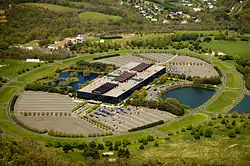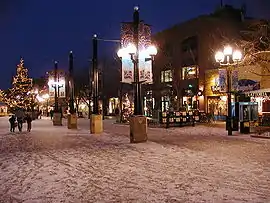Hideo Sasaki
Hideo Sasaki (25 November 1919 – 30 August 2000) was an American landscape architect.
Biography
Hideo Sasaki was born in Reedley, California, on 25 November 1919. He grew up working on his family's California truck farm, and harvesting crops on Arizona farms. He began his college studies at the University of California, Berkeley during the time of World War II. Owing to his Japanese descent, he was forced into the Poston internment camp in Arizona.[1] He was able to leave the camp upon volunteering to work as a farm hand in Sterling, Colorado. Soon after the war, he moved to Denver, Colorado where he met his wife, Kisa, a graduate of the University of Colorado. Sasaki then moved to the University of Illinois where he received Bachelor of Fine Arts and Landscape Architecture in 1946. In 1948 he graduated with a Master of Landscape Architecture from Harvard Design School. After graduation he returned to Illinois where he instructed for two years. For the next eighteen years (1953-1970) he became a professor and the chairman of the department of Landscape Architecture of the Harvard Graduate School of Design.[2] In 1953, he founded Sasaki Associates, incorporated in nearby Watertown, Massachusetts, where he was the president and chairman until 1980. He led the company's architects and planners in developing many noted commercial areas and corporate parks.[3] In 1956 he worked on the design of the Havana Plan Piloto with Mario Romañach and the Catalan architect Josep Lluís Sert.
During his later years he lived with his family (wife and two daughters, Rin and Ann) in Lafayette, California. He died on 30 August 2000 in a hospital in Walnut Creek, California.[4]
Style of design
Sasaki helped to modernize the concepts of Landscape Architecture. He created a practical approach to designing a landscape. In his works, several characteristics are taken into account, such as the historical, cultural, environmental, and social use of the land. Sasaki became famous for developing this concept of interdisciplinary planning. In all of the sites that he developed, a balance is implemented into the design. One aspect that Sasaki Associates pays particular attention to is the environmental aspect of the land. They have taken part in creating several "green designs." These designs are created to enhance or maintain the health of the environment. Some prominent examples can be viewed at the Utah State University Innovation Campus, The Virginia Biosphere, Walden Woods, and the Manulife Financial U.S. Operations Headquarters. Another facet of Sasaki's approach was the modernism that he worked into his college campus projects.
Major projects

Sasaki's firm operated under his own name, as Sasaki Associates, as Sasaki, Walker & Associates (with landscape architect Peter Walker), as Sasaki, Strong & Associates in Toronto (with landscape architect Richard Strong) and as Sasaki, Dawson, DeMay Associates, Inc..
- Foothill College, Los Altos Hills, California, 1957
- master plan for Goucher College, Towson, Maryland, 1957 [5]
- Washington Square Village, Greenwich Village, New York City, 1958
- master plan for Sea Pines Resort, Hilton Head, South Carolina, circa 1961
- Bell Labs Holmdel Complex, Holmdel Township, New Jersey, 1962
- consultant for York University, Toronto, 1962[6]
- master plan for University of Massachusetts Amherst, Amherst, Massachusetts, 1962
- John Deere World Headquarters, Moline, Illinois, 1964
- One Maritime Plaza, San Francisco, California, 1964[7]
- master plan for the Loomis Chaffee School, Windsor, Connecticut, 1967[8]
- One Shell Plaza, Houston, Texas, 1971
- urban design for Pearl Street Mall, Boulder, Colorado, 1977
- Forrestal Village, Princeton, New Jersey, 1986
- Waterfront Park, Charleston, South Carolina, 1990
- Euro Disneyland in Paris, France, 1992
- master plan for The Arboretum at Penn State, State College, Pennsylvania, 1999
- Performance Hall, Utah State University, Logan, Utah, 2006
- master plan for the Puerto Rico Convention Center District, 2006
- redesign and reconstruction of the Ithaca Commons, 2015
Awards and achievements
- In 1961 President John F. Kennedy appointed Sasaki to the U.S. Commission of Fine Arts. He held this position until 1971, being re-appointed by President Lyndon B. Johnson in 1965.[4][9]
- In 1971 he received the American Society of Landscape Architects Medal, the first person to do so.
- In 1973 he received the Allied Professions Medal from the American Institute of Architects.
- Sasaki was member of CU-Boulder's four-member design review board for 33 years.
- He was Chairman of the department of landscape architecture at the Harvard Graduate School of Design (1950-1968).
- He founded Sasaki Associates Inc. and was chairman and president of the board (1953-1980).
- He was a Juror for the Vietnam Memorial Competition in 1981, the Astronaut Memorial Competition in 1988 and the Peace Garden Competition in 1989.
- Sasaki was awarded the Centennial Medal for his impact on landscape architecture at the Harvard Design School, at a 1999 symposium on his work.[4]
- In 1984 Sasaki was awarded an honorary doctorate from the University of Colorado at Boulder.
References
- "Japanese American Internee Data File: Sasaki". National Archives and Records Administration. Retrieved 2019-08-18.
- Leslie Luebbers (February 23, 2011), "Sasaki, Hideo", Grove Art Online
- "In the boom years after World War II, Mr. Sasaki's team built some of America's first corporate parks, as companies like Upjohn and John Deere moved their headquarters from city to country." NYTimes obituary
- Raver, Anne (September 25, 2000), "Hideo Sasaki, 80, Influential Landscape Architect, Dies", The New York Times
- "History of the Buildings on Goucher's Towson Campus". Goucher College. Retrieved 2020-05-24.
- "UPACE | ERA Architects". www.eraarch.ca. Retrieved 2016-08-09.
- http://www.emporis.com/application/?nav=building&id=1maritimeplaza-sanfrancisco-ca-usa
- Hickok, George (The Loomis Institute). For Better and Grander Lives. 1989. p. 68. Check date values in:
|date=(help) - Thomas E. Luebke, ed., Civic Art: A Centennial History of the U.S. Commission of Fine Arts (Washington, D.C.: U.S. Commission of Fine Arts, 2013): Appendix B, p. 554.

